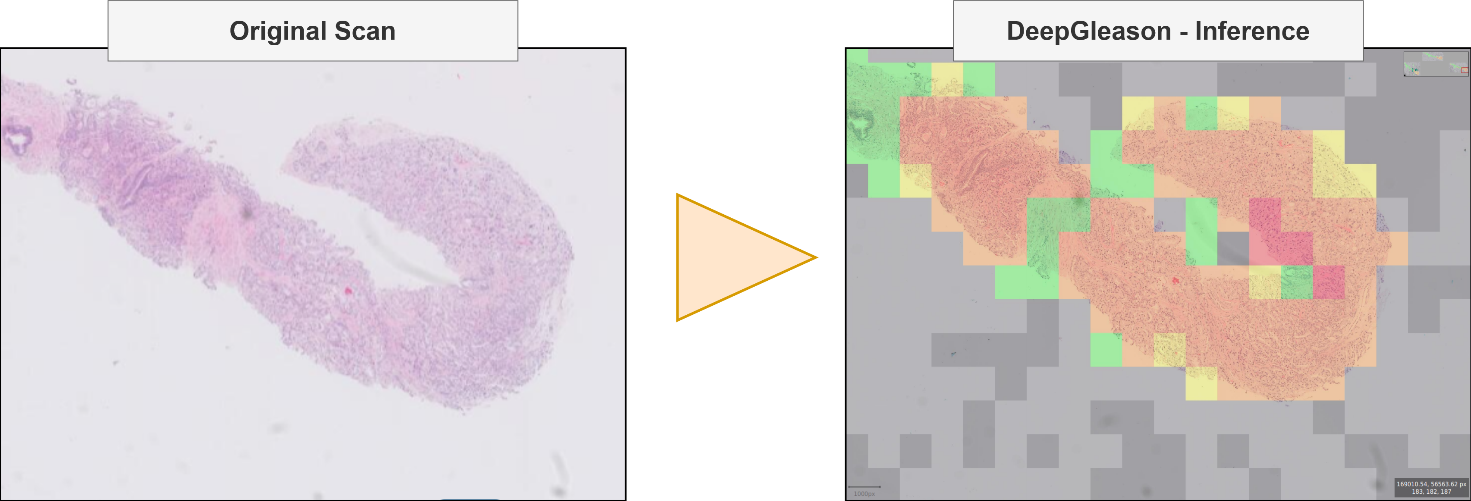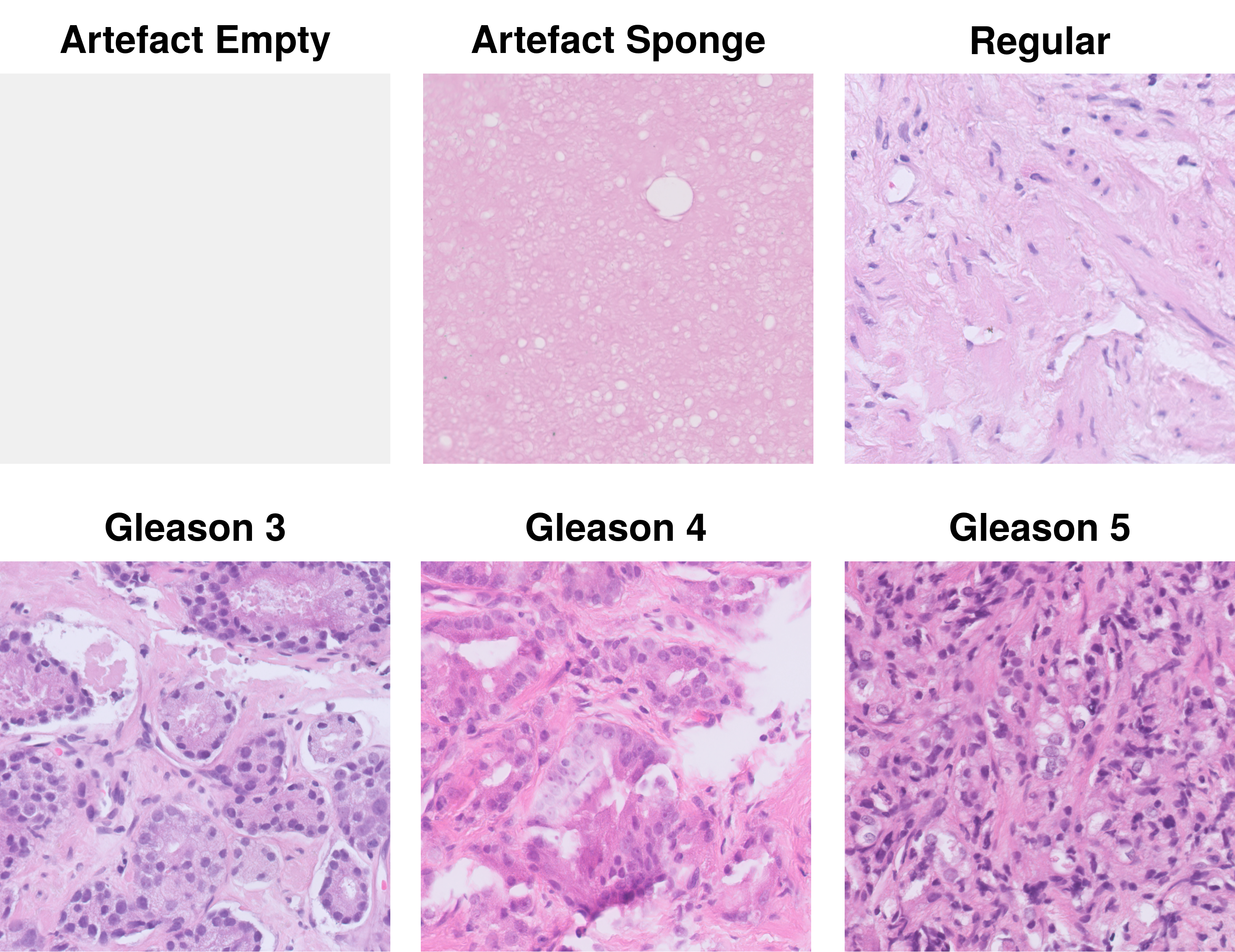Welcome to DeepGleason, an advanced software solution developed for inferring Gleason grading in prostate whole-slide images using a deep neural network. Our API is designed to assist pathologists and researchers in accurately analyzing and grading prostate tissue samples. With a focus on precision and efficiency, DeepGleason integrates seamlessly into existing workflows, providing a reliable tool for enhancing the diagnostic process. Explore the capabilities of our software and streamline your prostate cancer assessment with DeepGleason's neutral and effective approach to Gleason grading.
It computes a one of the following 6 classes per 1024 x 1024 tile: Artefact Sponge, Artefact Empty (including unclear tissue), Regular Tissue, Gleason 3, Gleason 4, Gleason 5
Example:
cd DeepGleason/
python code/main.py --input /sandbox/9f3fae7a6ff12c76fbbf89b9c50c66b6.ome.tiff \
--output /sandbox/ \
--model models/model.ConvNeXtBase.hdf5 \
--predictions /sandbox/predictions.csvInput:
- Whole-slide image of prostata cancer
- DeepGleason deep neural network model
Output:
- BigTiff of computed classes as overlay
- CSV file containing class predictions & confidence for each tile
usage: code/main.py [-h] [-g GPU] [--cache CACHE] -i INPUT [-o OUTPUT] [--model MODEL] [--generate_overlay] [-p PREDICTION]
DeepGleason: Prediction
optional arguments:
-h, --help show this help message and exit
-g GPU, --gpu GPU GPU ID selection for multi cluster
--cache CACHE The location for temporary files that care generated during generation
-i INPUT, --input INPUT
Path to the input slide
-o OUTPUT, --output OUTPUT
Path where the slides are stored
--model MODEL Model the XAI is computed upon
--generate_overlay merge prediction distribution with base image as overlay
-p PREDICTION, --predictions PREDICTION
output CSV containing predicted soft labelsDocker Usage:
# Pull the image from the Container Registry
docker pull ghcr.io/frankkramer-lab/deepgleason
# Create a data directory and move whole-image slides into it
mkdir /home/main/DeepGleason.data
mv my_slide_1.tiff /home/main/DeepGleason.data/
mv my_slide_2.tiff /home/main/DeepGleason.data/
mv my_slide_3.tiff /home/main/DeepGleason.data/
# Run the DeepGleason container
docker run \
-v /home/main/DeepGleason.data:/data --rm \
ghcr.io/frankkramer-lab/deepgleason
## all results will be stored in the created DeepGleason.data directoryDownload Git repository:
git clone https://github.com/frankkramer-lab/DeepGleason.git
cd DeepGleason/
git lfs pullThis repository contains requirements.txt. Use it to install the dependencies as such:
pip install -r requirements.txtOne of these dependencies is pyvips. PyVIPS may require the installation of LibVIPS on the system. Please refer to their installation guide here.
This program utilizes the PyVIPS library to load and store images and AUCMEDI to run the model.
The implemented medical image classification pipeline can be summarized in the following core steps:
- Slide preparation with PyVIPS: 1024x1024 pixel tiles
- Tile preprocessing: Padding, resize, pixel intensity normalization
- Deep Learning model architecture: ConvNeXtBase
- Slide reconstruction to bigTIFF overlay
The open-source software AUCMEDI allows fast setup of medical image classification pipelines with state-of-the-art methods via an intuitive, high-level Python API or via an AutoML deployment through Docker/CLI.
https://github.com/frankkramer-lab/aucmedi
This pipeline was based on AUCMEDI, which is an in-house developed open-source framework to setup complete medical image classification pipelines with deep learning models on top of Tensorflow/Keras. The framework supports extensive preprocessing, image augmentation, class imbalance strategies, state-of-the-art deep learning models and ensemble learning techniques. The experiment was performed with a NVIDIA A100-sxm 40GB.
We were able to achieve a strong model for Gleason grading in prostata cancer.
The CLI supports multiple inputs, but it is assumed that the names of all files are unique. If this is not the case this script will crash or overwrite files.
By default a color map is generated. If it should be overlayed over the initial image use --generate_overlay.
This program stores intermediate results in a cache folder. This will usually default to the system partition.
Pathology images are usually heavily compressed and the uncompressed or recompressed intermediatries tend to take up a lot of hard drive.
If your system drive does not have a lot of space available please utilize the --cache argument to proviide a different location.
Should the script crash, rerunning the same command will resume progress.
Dr. Dominik Müller
Email: dominik.mueller@uni-a.de
Workgroup: RAIMIA - Reliable AI-driven Medical Image Analysis
IT-Infrastructure for Translational Medical Research
University Augsburg
Bavaria, Germany
This project is licensed under the GNU GENERAL PUBLIC LICENSE Version 3.
See the LICENSE.md file for license rights and limitations.






